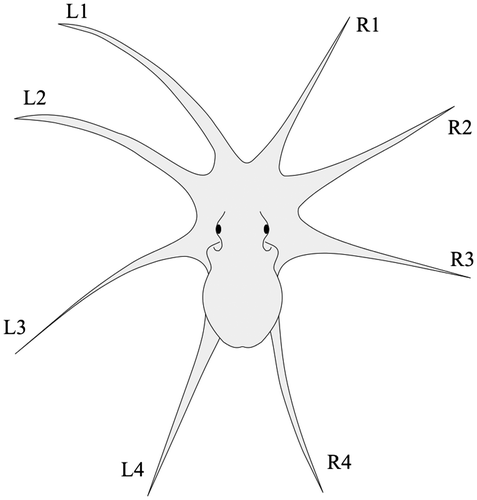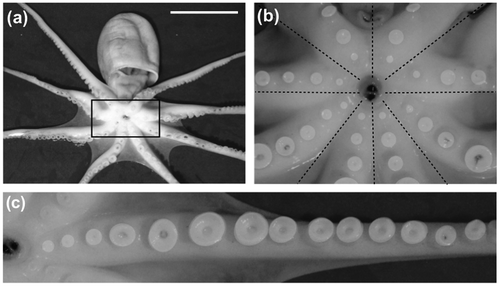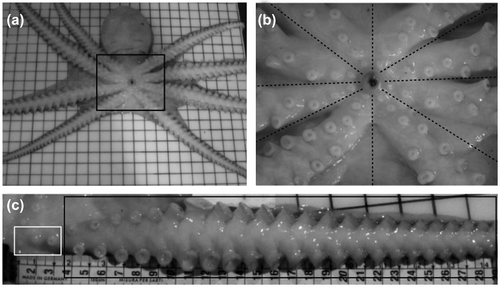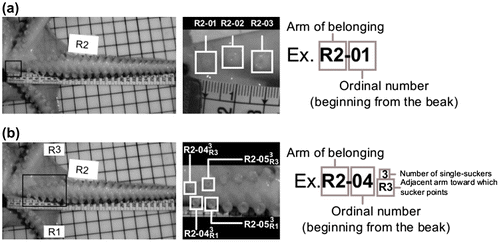Abstract
In the literature, a reference terminology for labelling octopus arms exists, but a convention for the labelling of octopus suckers is so far lacking. The precise identification and subsequent ability to address a specific sucker is impossible without some type of convention. In this work, we propose an Octopus Sucker Identification Code, with three/five characters, depending on whether the octopus species has one or two rows of suckers. Specifically, two characters identify the arm to which the sucker belongs, one integer identifies the sucker position along the arm and two subscript characters (present in cases of octopus species with two rows of suckers) identify the adjacent arm towards which the sucker is faced. The proposed code allows the unequivocal identification of the suckers of any octopus arm of any octopus species.
Keywords:
Introduction
In scientific communication, a common terminology is essential to clearly identify objectives, arguments and terms of discussion. The need for an unambiguous reference terminology, which permits a clear means of communication, is evident in various fields (Vasudeva Citation2004; Norman & Hochberg Citation2005).
Terminology for octopus arm labelling already exists in the state of the art. This convention labels arms from middorsal to ventral as left and right and numbered from one to four (Figure ) (Wells Citation1978). This code has been widely used over the years as a reference for the scientific community (Mather Citation1998; Byrne et al. Citation2006).
Figure 1. Labelling of octopus arms. Octopus arms are labelled from middorsal to ventral on the left and right and numbered from one to four (Wells Citation1978).

A convention for octopus sucker labelling is, however, still lacking. The octopus has eight arms, each of which is equipped with one or two rows of suckers (Hochberg et al. Citation1992). There are several hundred suckers per arm, and thus a few thousand suckers per animal. In this elaborate scenario, the exact identification of a single sucker is absolutely impossible unless a code is adopted. This problem is particularly important considering the wide interest in the study of suckers expressed by the scientific community (Kier & Smith Citation1990; Smith Citation1991; Smith Citation1996; Johnsen et al. Citation1999; Kier & Smith Citation2002; Grasso & Setlur Citation2007; Grasso Citation2008; Tramacere et al. Citation2013) and also considering that there are differences among suckers belonging to the same animal (Voight Citation1991).
Given these considerations, octopus sucker labelling is crucial; therefore, we here introduce an Octopus Suckers Identification Code (OSIC) that enables the unequivocal identification and labelling of suckers.
Methods and description of coding scheme
Arrangement of suckers on octopus arms
In nature, species of the order Octopoda have uniserial or biserial suckers for each arm (Hochberg et al. Citation1992). In the first case, octopus presents one row of suckers (referred to as 1r-octopus throughout this work; e.g. genus Eledone); in the latter case, octopus has two rows of suckers (referred to as 2r-octopus in the present work; e.g. genus Octopus, Enteroctopus). 2r-octopus species present the following arrangement: the suckers localised on the more proximal part of the arm (called single-suckers in this work) are radially distributed around the beak in correspondence to the direction of each arm (Figures (a) and (b)). These suckers have no particular alignment or pairing; they appear to be consecutively distributed towards the direction of arm growth (Figure (c)). All the other suckers, localised on the remaining part of the arm up to the tip of the arm, are instead paired; in this work, these are called paired-suckers (Figure (c)). In contrast, 1r-octopus species have only single-suckers along the whole length of each arm (Figure ). Figure summarises the sucker arrangements in the 2r-octopus and 1r-octopus, respectively.
Figure 4. Schematic sucker arrangement. Ventral view of the sucker arrangements in (a) 2r-octopus and (b) 1r-octopus, respectively.

Figure 3. General sucker arrangement in 1r-octopus. (a) Ventral view of sucker arrangement in E. moschata (an example of 1r-octopus). The scale bar shown in the image represents 5 cm. (b) Enlargement of suckers around the beak (black box in (a)) and the subdivision of these suckers for a single arm. (c) Detail of sucker distribution on a single arm.

Figure 2. General sucker arrangement in 2r-octopus. (a) Ventral view of the sucker arrangement in O. vulgaris (an example of 2r-octopus). The grid that appears in the image represents 1 cm. (b) Enlargement of suckers around the beak (black box in (a)) and the subdivision of these suckers for a single arm. (c) Detail of sucker distribution in a single arm. The white box highlights single-suckers, and the black box highlights paired-suckers (beyond the frame of the picture, the paired-suckers extend for the entire length of the arm to the arm tip).

Octopus Suckers Identification Code (OSIC)
To unequivocally identify a specific sucker on an octopus arm, two discriminant factors are needed: (i) the arm to which the sucker belongs; and (ii) the exact location of the sucker on the arm.
We define the first discriminant factor of our sucker identification code from the known terminology for octopus arm labelling (Wells Citation1978). Such factor consists of two characters that codify the arm to which the sucker belongs (e.g. R1, first right arm; L1, first left arm, etc.). Then, we define the second discriminant factor as the identification of the sucker position on the arm. Moreover, we consider as a fixed reference the octopus’s beak, because it is a rigid feature of the animal, well recognisable and always present in an octopus (even in cases of mutilated animals). As a consequence of this, we labelled each sucker with an incremental ordinal number from the proximal to distal part of the arm.
At this point, single-suckers, namely all suckers of 1r-octopus and the proximal suckers on 2r-octopus, are unequivocally identified (Figure (a) and (b)). The paired-suckers, however, are not yet clearly identified. Because these suckers are paired, the same ordinal number labels two suckers (one on each side), and additional information is needed to specify which sucker is being considered (Figure (b)). To address this ambiguity, we introduced subscript characters to the ordinal number to specify the adjacent arm toward which the sucker is faced. In this way, paired-suckers are also clearly identified.
Figure 5. Sucker arrangement on the arm. Ventral view of (a) 1r-octopus arm and (b) 2r-octopus arm. All suckers in the 1r-octopus arm and the more proximal suckers in 2r-octopus arm can be labelled simply by an ordinal number (with the assignment beginning at the beak and extending toward the tip of the arm), whereas the remaining suckers are paired and the same ordinal number would label two different suckers (one on each side).

Another piece of information that is important in the case of 2r-octopus species is the number of single-suckers preceding the paired-suckers on the same arm. This information is useful to provide further detail about the sucker distribution.
In summary, we propose a code with three/five (depending on whether a 1r-octopus or 2r-octopus species is being analysed) characters: two characters that identify the arm to which the sucker belongs (in accordance with the already widely accepted arm labelling convention); one integer that identifies the suckers’ ordinal number (with the beak as a fixed reference); and two subscript characters (present only in the labelling of paired-suckers of 2r-octopus) that identify the adjacent arm towards which the sucker points. Another optional integer, expressed as the apex of the ordinal number in paired-suckers of 2r-octopus, can be useful to identify the number of single-suckers preceding the paired-suckers in an arm. Figure shows a graphical example of sucker identification in 2r-octopus.
Results
Validation of “Suckers Identification Code” for octopus
To evaluate the usability of the identification code suggested in this work, we administered an ad hoc test. 20 animals (10 Octopus vulgaris (700–2000 g, five male and five female), as example of 2r-octopus species; and 10 Eledone moschata (300–600 g, five male and five female), as example of 1r-octopus species) were used for the evaluation test.
The single-suckers of the O. vulgaris animals were, generally, more than two and less than ten, having a diameter of few millimetres, whereas the paired-suckers had a diameter of few millimetres in the more proximal portion of the arm. In the remaining part of the arm, the sucker diameter increased up to few centimetres in correspondence of a third of the entire arm length and, then, decreased again up to few millimetres towards the arm tip.
The single-suckers of the E. moschata animals generally had a diameter of few millimetres, increasing up to a third of the entire arm length and decreasing again towards the arm tip. All the procedures carried out during this investigation with the animals complied with the new EU Directive 2010/63/EU (Protection of animals used in experimentation).
The test was administered to a group of 25 people chosen randomly among octopus investigators and among a group of people who did not have any experience or knowledge about this type of study. Written instructions explaining how to use the OSIC method were provided to the group before starting the test. The test consisted of two different sections. The first section aimed to evaluate the volunteer’s ability to decode an OSIC code. In this case, 10 different OSIC codes were provided, and the volunteers were asked to mark the suckers corresponding to the codes on pictures of an octopus (O. vulgaris or E. moschata). The second section aimed to evaluate the volunteer’s ability to formulate an OSIC code. In the latter, a picture of an octopus (O. vulgaris or E. moschata) with 10 different marked suckers was provided to the testing group, and the volunteers were asked to formulate the code for each marked sucker.
The gathered results showed an average of 9.2/10 and 9.4/10 for the first (OSIC decoding) and second (OSIC formulation) sections of the test, respectively. The minor mistakes observed could be reasonably attributed to simple carelessness, as verified after the tests were completed. This outcome demonstrates the intuitiveness and ease of use of the proposed method.
Discussion
In conclusion, the present work describes a new method for identifying octopus suckers in a simple, unequivocal and non-redundant way. This code uses only the information that is strictly necessary to locate the sucker on the animal, and it is fully coherent with the arm labelling scheme already proposed and accepted by the scientific community. The proposed sucker labelling format will be particularly useful in several scientific works dealing with octopus. One example is the study of enlarged suckers as an indicator of male maturity in octopus (Johnsen et al. Citation1999). In this case, the exact localisation of these enlarged suckers would be particularly important to verify whether male maturity is always expressed in the same portion of the arm or, in contrast, in a random way. Another application of our method is in studies of grasping and manipulation (Grasso Citation2008). It has been demonstrated that coordination among different suckers exists, and, indeed, it would be particularly interesting to identify exactly which suckers are involved in the interaction. In conclusion, our identification code for octopus suckers was validated with both 2r-octopus and 1r-octopus species and is applicable to all octopus species.
References
- Byrne RA, Kuba MJ, Meisel DV, Griebel U, Mather JA. 2006. Does Octopus vulgaris have preferred arms? J Comp Psychol. 120:198–204.
- Grasso FW. 2008. Octopus sucker-arm coordination in grasping and manipulation. Am Malacol Bull. 24:13–23.
- Grasso FW, Setlur P. 2007. Inspiration, simulation and design for smart robot manipulators from the sucker actuation mechanism of cephalopods. Bioinspir Biomim. 2:S170.
- Hochberg FG, Nixon M, Toll RB. 1992. Order OCTOPODA leach, 1818. In: Sweeney MJ, Roper CFE, Mangold KM, Clarke MR, Boletzky SV, editors. “Larval” and juvenile Cephalopods: a manual for their identification. Washington, DC: Smithsonian Institution Press; p. 213.
- Johnsen S, Balser EJ, Widder EA. 1999. Light-emitting suckers in an octopus. Nature. 398:113–114.
- Kier WM, Smith AM. 1990. The morphology and mechanics of Octopus suckers. Biol Bull. 178:126–136.
- Kier WM, Smith AM. 2002. The structure and adhesive mechanism of octopus suckers. Integr Comp Biol. 42:1146–1153.
- Mather JA. 1998. How do octopuses use their arms? J Comp Psychol. 112:306–316.
- Norman MD, Hochberg FG. 2005. The current state of octopus taxonomy. Phuket Marine Biological Center Research Bulletin. 66:127–154.
- Smith AM. 1991. Negative pressure generated by octopus suckers: a study of the tensile strength of water in nature. J Exp Biol. 157:257–271.
- Smith AM. 1996. Cephalopod sucker design and the physical limits to negative pressure. J Exp Biol. 199:949–958.
- Tramacere F, Beccai L, Kuba M, Gozzi A, Bifone A, Mazzolai B. 2013. The morphology and adhesion mechanism of octopus vulgaris suckers. PLoS One. 8:e65074.
- Vasudeva RMK. 2004. The importance of botanical nomenclature and synonymy in taxonomy and biodiversity. Curr Sci. 87:602–606.
- Voight JR. 1991. Enlarged suckers as an indicator of male maturity in octopus. Bull Mar Sci. 49:98–106.
- Wells MJ. 1978. Octopus: physiology and behaviour of an advanced invertebrate. London: Routledge/Chapman & Hall.
